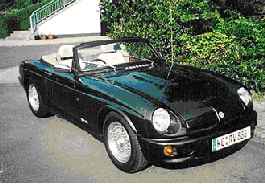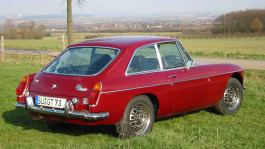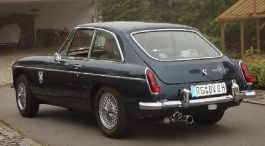V8
Newsletter
for December 2004 published in Safety
Fast!, the award winning monthly magazine of the MG Car Club

Peter
Garton (Woodcote Green 1238)
has one of the four RV8s in Germany with an appropriate number plate.
(Photo: Peter Garton)
This
month we have a feature article on V8s in Germany as it is clear that
MG enthusiasts there have spotted what tremendous value the MGBGTV8
is as a classic sportscar - plus there is a very useful road tax advantage
now the cars are over 30 years old. We also have a workshop note describing
a hydraulic vehicle lift which makes working on a V8 very convenient
- it's from our gadgets man, Gavin Bailey.
To lift or not to lift, that is the question
Dr Gavin Bailey (RV8 BRG 0766 and V8 Glacier White 0199) from Surrey
describes how he tracked down a hydraulic lift and has found it very
useful. (Jun 04)
After a number of years dragging a trolley jack around my driveway,
and latterly my garage, to lift my MGBGTV8 onto axle stands, and even
then having limited clearance underneath to work on the car, the thought
of an arrangement that would give greater access was of increasing
appeal. From my early days of working on cars in my father's garage,
I had long lusted after some kind of ramp or pit, and following a
recent move to a house with a garage that had sufficient space to
accommodate such an arrangement, I started to look in earnest at the
various options.
What are the ramp or pit options?
If one wants good access to the underside of the car, there are really
only two serious alternatives: some form of pit sunk into the garage
floor with boards covering it when it's not in use; a ramp to lift
the car off the ground. The latter come in two basic forms - the four
post variety which you drive on and which lifts the whole car off
the ground, wheels in channels and which is a necessity for MoT testing
stations; and the two post variety or variations on the theme which
have swinging arms with rubber pads which when placed under the jacking
points, allow you to raise the car off the ground. The latter option
crucially, allows the wheels to hang free giving good access to the
brakes and suspension.
Having explored the options, I was quickly able to rule out a pit,
as even with the launch of the excellent 'Mechmate' (which is essentially
a lined fibreglass moulding for the pit), they all required a significant
amount of excavation which was a non-starter with my existing garage.
I then started to look at the other option of a lift which had to
be compact enough to operate in |
my
garage which although
wide, had limited headroom given the rafter arrangement
supporting the roof.
 Glacier White 0199 up on the hydraulic ramp. (Photo: Gavin
Bailey)
Glacier White 0199 up on the hydraulic ramp. (Photo: Gavin
Bailey)
As chance would have it I came across an AL-2006 'portable' hydraulic
ramp made by Autec of Holland on Holden Classic & Vintage's
stand) at the Goodwood Festival of Speed. The web addresses are:
http://www.autec-lifts.com/home_nl.php and
http://www.holden.co.uk/
Their display attracted a lot of attention as the lift was supporting
their large Transit van. Although I was impressed with the engineering,
I was not ready at that point to shell out the £1,200 (now £925
+ VAT), they were asking for it. Being a disciple of E-Bay, I started
to look for second-hand ramps, and quickly found that there were many
advertised for sale, commonly coming from garages that were closing
down. After a short search I was lucky enough to find one second-hand
on E-Bay, and eventually ended up paying just over half the new price
for a ramp that was only a few years old, having had only light occasional
use. I would mention at this point that one needs to be careful when
buying second-hand equipment of this kind, ensuring

Autec hydraulic ramp in action. (Photo: Gavin Bailey)
that the equipment has been regularly serviced and is safe to use.
One can take no chances with a ramp that is going to support the weight
of a motor vehicle, especially when you're going to be working underneath
it! After getting the lift home (although described as 'portable',
four of us just managed to lift it into my 6x4 trailer), I installed
it in my garage. After changing the hydraulic fluid it was ready to
use.
So how does it work?
From the photographs you can see it is essentially comprises a steel
frame with a large hydraulic ram that lifts the platform to which
|
four
swinging arms carrying rubber jacking pads are attached. The ram is
connected to a separate single-phase 240v hydraulic control unit which
has two switches - one to power up the unit, and a separate toggle
to lift or lower the ram. To use the lift, you simply drive the car
over the lift, swing the arms out, and position the rubber jacking
pads (which slide along the lifting arms thus offering a multitude
of adjustment), under the jacking points. It's then a simple matter
of checking that all jacking pads are aligned under the relevant jacking
points before operating the lift and raising the vehicle. The ramp
will lift a vehicle of up to 2 metric tonnes up to a maximum of just
over a metre in just over 50 seconds.
Given the weight of the vehicle, and the fact that you are going to
be working underneath it, safety is a prime consideration. To ensure
the vehicle is safely supported when raised, the lift has a series
of mechanical stops or detents, which are essentially steel stops
which are welded to the bottom frame of the lift. As you raise the
vehicle,
the lift 'clicks' past each detent in turn. Once you have reached
the desired height, it's a simple matter of lowering the ramp slightly
so that the lift locks firmly in place against the steel stop. There's
no need for any further support as the weight of the vehicle is off
the hydraulics, and the ramp is securely and physically locked in
place. This mechanical lock is an essential safety feature you are
not relying on the hydraulics when you are under the car! To lower
the vehicle, simply raise the ramp slightly before 'capsizing' a catch
on one of the supporting arms. This lifts the arm sufficiently to
pass over the metal stops and lower the vehicle to the ground.

The Autec ramp lifts the car well clear of the ground. (Photo:
Gavin Bailey)
So how does the ramp work with an MGBGTV8 and RV8?
I first tried it with my MGBGTV8 (a chrome bumper car, although rubber
bumper cars should be no different), and the lift worked perfectly.
The car had sufficient ground clearance to drive over the ramp, and
once swung into position, the pads located securely under the spring
pans on the front suspension, and under the rear spring hangers just
in front of the rear wheels. With the RV8 however, it was a different
story. Firstly, the lower ground clearance posed a problem and I had
to source two short planks of timber to place alongside the ramp so
that when I drove the car over the ramp, the catalysts did not foul
the ramps frame. Once in position however, the supporting pads on
the front jacking arms were again placed under the spring supporting
pans at the front, whilst the rear pads fitted under the spring and
torsion bar mounting brackets at the rear. Although more of a fiddle
with the RV8, the whole setup makes the car far easier to work on
compared to scrabbling around on the ground under a car supported
by axle stands.
Extent of the access
Lastly, one of the most important issues when choosing a ramp or lift
is the extent of access to the underside of the vehicle when up in
the air. Of course a two-post lift with swinging arms is the ultimate
wheel- |
free lift which also
gives access to the underside of the vehicle for changing exhausts,
gearbox etc. On my Autec model, access to the underside of the vehicle
whilst on the lift is of course restricted by the frame of the lift
itself. All is not lost however, as Autec can supply extra long axle
stands which, when place under the vehicle, allow the ramp to be lowered
(and even removed) leaving the vehicle up in the air and with full
access to the underside.
So what are my conclusions?
If you do all the maintenance work on your own cars and have the space,
a ramp is a very worthwhile investment. My next step is to sink the
ramp into a shallow pit in the floor of the garage which will allow
me to ensure the floor is clear when the ramp is not in use. I've
got the steel frame waiting for the pit aperture - it's now just a
question of getting digging!!! If anyone has any further questions,
I'm happy to answer them by email (see the V8 Website for my contacts)
or at any of the V8 Events, including Silverstone.
New range of V8 Regalia launched
A new range of regalia for V8 enthusiasts is now available. The fleeces,
polo shirts, sweatshirts and other items have modest V8 Register and
Club badge logos. Full details are on the V8 Website where you can
order by mail order or the convenient V8 Online Sales system Contact
Mike Russell at mikerussell@v8register.net or on 01494 814371.
RV8 reimports keep coming!
Over the last few months a steady flow of RV8s has continued to come
back to the UK through both local agents in Japan acting for UK purchasers
and through specialist UK based RV8 reimporters like Classic Sportscar
Consultants in Buckinghamshire and HS Imports in Somerset. One low
mileage example which is on its way back from Japan is Woodcote
Green 1800 with only 9,800 miles from new. Fred Jenns of Classic
Sportscar Consultants says "it would be very sorely tempting
to call this car the only 3 year old RV8. The original MG dealer who
supplied the car bought the car back from its first owner after three3
years on the road, since which time it has been exhibited in his showroom.
As you would expect, it is simply beautiful. More detailed digital
photographs can be sent on request". This car was on offer at
£15,950.
One RV8 to look out for and probably avoid is Oxford Blue 1564.as
it suffered major offside impact and front damage following a reported
accident at the auction. Regular reports from the RV8 auctions in
Japan are posted on the V8 Website with news provided by several local
contacts.
The annual V8 Curry Night is the first event in 2005. It is
on Saturday 5th February at 7.00pm at the Last Viceroy in Bourne End
near Marlow. The V8 Curry Master, David Biddle, is organising bookings
and needs confirmation from you so he is able to ensure sufficient
places at the curryhouse. He can be contacted on 01753 892714 or at
davidbiddle@v8register.net by email. Full details including location
maps and directions are on the V8 Website. Later that month Clive
Wheatley will have a small V8 stand at the Classic Car Show at
Stoneleigh on Sunday 27th February. All the V8 events are set
out on the Rolling V8 Calendar on the V8 Website - if you do not have
internet access, just call Victor Smith and he will arrange for a
printout to be sent to you by mail or fax. Following the success of
the V8 Shropshire Tour 2004, Lynn and Andy Vine have volunteered to
organise a V8 Essex Tour over the long weekend Friday 9th to Monday
12th September 2005. Details will follow. |
Increasing
interest in MGV8s in Germany
There has been a noticeable increase in interest in MGV8s from Germany
during 2004 with many new registrations from German V8 enthusiasts
and reports of V8s bought by German enthusiasts in the UK. The V8
Register database records 22 MGV8s and 4 RV8s in Germany, so it seems
a good time for a review of the V8 scene in Germany.

Teal Blue 2131 at Alhorner-Heide airport near Bremen
for a two day event in 2003. (Photo: Walter Kallenberg)
Only a very few LHD V8s were produced by the Factory and many
have subsequently been acquired by enthusiasts in Switzerland and
Germany. One of our Swiss members and a founder member of the V8 Register
back in 1978, is Tom Studer (Damask 0109) who documented the
LHD models in his thorough review over 20 years ago. Another longstanding
member is the irrepressible Walter Kallenberg (Teal Blue 2131)
who has attended very nearly every Silverstone meeting since 1978,
many in his V8! But getting a V8 into Germany as a production car
has not been straightforward as Allan Doyle explains below but today
things are much different. "With current UK prices for V8s remaining
relatively low, German MG enthusiasts are now waking up to the fact
that V8s in the UK are an under-priced classic. An official market
analysis here gives the average price for a V8 in condition 2 as EUR
15200 (about £10,500) representing an opportunity of importing
a V8. - a classic sportscar which represents good value in every sense!
A V8 even got featured on the front page of Motor Klassik (a large
circulation German magazine) in September. The eight page article
contained a number of goofs but the featured Damask car looked excellent.
There were lots of good photographs and the car got a very positive
write up. MG-Rover also managed to get a full page advert for the
new MGZT-T V8 in that edition which was very good publicity for a
car which is little known in Germany".

Damask 1721 which was comprehensively restored by
Theo Klick and completed in 2004. (Photo: Theo Klick)
Early imports of the Factory V8 model to Germany involved a complex
procedure requiring individual acceptance by the authorities because
there is no Allgemeine Betriebserlaubnis (homologation) for the car
in Germany. Allan Doyle (Damask 1667), an Englishman living in Germany
for many years, says "this procedure varied from place to place
but in the worst possible case one could be requested to prove the
engine capacity by measurement. Then a collection |
of bills, brochures
and general sales literature helped to convince a disbelieving local
TÜV-engineer that the V8 was a standard road-going car and not
a home-made hotrod. The only complaints in my case were against the
seat belts which "only" had a BS-Kite mark and not a DIN
reference, and with the composite Dunlop wheels. Today things have
changed for the better so a photocopy of a friendly V8 owner's logbook
with dimensions in millimetres, noise in dB and a whole load of type
numbers now suffice. Officially the car is classified as a four seater".

Daniel Heyer (Damask 0987) at speed on the track in Germany.
(Photo: Daniel Heyer)
But why are V8s now becoming popular in Germany? Well earlier
this year Allan reported that "one reason for the recent increased
interest in Factory V8s in Germany is possibly the motor tax regime
here. Germany has a very complicated motor tax system based on engine
capacity and "cleanliness" based on Euronorm, an old 3.5
litre V8 costs a fortune in motor tax whilst a new, small-engined
car is charged less than in the UK. However, 30 years after the date
of first registration, this changes and the car becomes an "historic
vehicle" for which a much lower blanket tax figure comes into
effect making a 1974 MGBGTV8 suddenly very attractive!". Historic
vehicles then have a special registration plate with an "H"
denoting a historic vehicle. It is a pity our own authorities do not
share the same approach in the UK - instead that miser Gordon Brown
chopped off the rolling annual tax exempt concession on cars over
25 years old shortly after his government's election in 1997, so that
many chrome bumpered V8s missed the frozen cut-off date by less than
12 months!

Kai Knickman (Damask 0945) in Germany. (Photo: Kai
Knickman)
Kai Knickman has been a regular German visitor to Silverstone in recent
years and this year took part in the V8 Track Laps session. Daniel
Heyer (Damask 0987) uses his MGBGTV8 for track and competition work
in Germany. Earlier this year Peter Forstner bought an exceptional
V8 (Bracken 1218) from David |
Waterton. Another
V8 member is Theo Klick (Damask 1721) who reported the completion
of a comprehensive restoration in May.
A quick survey of cars registered in Germany shows that Damask
is the favourite colour; a third of MGV8s registered with us are
that colour. There are a number of conversions and a few RV8s but
most V8s are the original Factory cars. There was a discussion on
converting RV8s to LHD on the MGDC website which shows the interest
here. The conclusion was "yes but …" and it was surprising
to read that quite a few people actually value a RHD car as genuine.
For some the ultimate solution is of course to build a car to their
own specification. This is exactly what Jörg Hüskin did
and after 22 months of assembly, the car became road legal this summer.
The basis was a BMHT shell, an all new 4.6 litre engine and an R380
gearbox to mention just a little of the specification".

Jörg Hüskin (Blue 3113) built this beautiful
V8 from a Heritage shell with a 4.6 litres engine. (Photo: Jörg
Hüskin)
Members with RV8s in Germany include Anja Smith (Oxford Blue 0761),
Jurgen von Seggem (Woodcote Green 0884), Juergen Krause (Woodcote
Green 2209) and Peter Garton (Woodcote Green 1238) who has recently
had a power steering conversion fitted to his car, and is pleased
with the result.

Eva Maas-Doyle on a warm day at Blenheim Palace during the
V8 25th Anniversary Tour in 2003. (Victor Smith)
Allan and Eva Doyle brought their V8 over to the UK in 2003
for the V8 25th Anniversary and again in 2004 for a sightseeing trip
to London and then onto the Midlands for a family wedding, followed
by an extended return trip via Denmark and Sweden. Allan notes that
"as both the cars and their owners and children are getting older,
the problem of lack of rear legroom solves itself! We now take the
MG on holiday with just the two of us much as we did 25 years ago.
This Summer's we drove from southern Germany for a week in the UK,
before crossing from Harwich to Esbjerg and on to the Danish club's
50th anniversary meeting which very well organized. From there we
went on to southern Sweden where we met up with Ulf Lindquist (Midnight
Blue 0342), and then home. A wonderful little trip with the sunroof
open most of the time. The car performed faultlessly and always returned
mpg figures in the high 20s (that is around 10ltr/100km)".
Maintaining a V8 in Germany has its challenges as you are further
away from the home country, but with the technical support available
through the V8 Workshop Notes series and the V8 Bulletin Board, German
members feel they are much closer. This was demonstrated shortly after
Silverstone earlier this year, when Kai Knickman sought help with
an overheating problem experienced on his return journey to Germany
|
by posting a message
on the V8BB. Kai Knickman takes up the story - as there are not too
many V8s over here in Germany, it has always been one of the highlights
of the Summer season to get over to Silverstone for the annual meeting
in order to reunite Lucy, as my '73 chrome bumper V8 (Damask Red 0945)
is affectionately known in our family, with other MGs and V8s. From
my home town of Ludwigsburg in the south of Germany near Stuttgart,
it is a pleasant drive of around 600 miles, more than half of it on
wonderful deserted French back roads. It was later after the Channel
crossing in Lucy´s home country that things started to go wrong
with overheating, water being pushed out of the expansion tank and
so on. But this only happened during traffic jams and as soon as the
road was open again, everything worked well. So I enjoyed a wonderful
weekend with likeminded V8 enthusiasts in Silverstone including a
spirited track lap session). I picked up a great deal of good advice
with regard to my overheating problem, mostly pointing towards cylinder
head gasket failure, and returned home safely with my sixpack of Perrier
bottles being used for refilling the cooling system on the way!

Kai Knickman (Damask 0945) at one of the stages during the
V8 Tulip Tour, part of the V8 25th Anniversary week of events in 2003.
(Photo: Victor Smith)
The following weekend all the parts necessary for a rebuild were ordered
from the trusty source of Clive Wheatley's mgv8parts. Dismantling
showed a suspected cylinder head gasket failure between cylinder eight
and the water passage from block to head was still small, but taken
with the typical minor things you tend to find whenever you take something
apart that may not have been dismantled since the car's rebuild with
MGBHive in the mid-nineties, it clearly needed urgent attention. Right
now new composite head gaskets look the part, heads have been thoroughly
cleaned from oil sludge (what a mess!) and the tubular manifolds have
been insulated with exhaust wrap, which significantly lowers the underbonnet
temperatures - you can even touch them know after a long drive!
Unfortunately, the season had passed by quickly while I was taking
care of Lucy's mechanical disorders, so the local hill climb event
was only visited, and I missed the opportunity of taking part - what
a pity. Fortunately I was able to switch Lucy`s registration to a
"historic" one which is available only for unmolested cars
being more than thirty years old, and now she is insured and registered
for use all the year round. Costs are significantly lower this way
with just a lump sum tax of £120 a year instead of the typical
German emission and displacement related one for everyday cars, which
removed the better part of £800 in previous years due to the
non-catalyst 3.5 litre engine. So I'm looking forward to some nice
days out later in the Fall and Winter - and to next year's Silverstone
meeting. Hope to see you there! |
|
